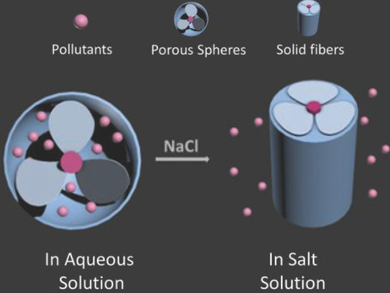Organic pollutants in water have an impact on both water ecosystems and human health. Therefore, their removal and prevention is of great interest. Metal-organic frameworks and activated carbons are the most common sorbent materials used. However, regeneration of these sorbents is costly, requires a lot of solvent, and does not restore the material to full performance.
A promising alternative is the use of aromatic rod amphiphiles. These consist of conjugated carbon and hydrophilic coil segments and can be tailored to reversibly sequester molecules of interest. Zhegang Huang, Sun Yat-sen University, China, and colleagues have synthesized a conjugated carbazole derivative to obtain a novel propeller-shaped aromatic amphiphile that aggregates into hollow porous spheres of approximately 7 nm in diameter (see picture). These pores provide an excellent carbon environment to adsorb dissolved organic contaminants.
Under addition of salt, the propeller segment flattened to enhance π-π-interactions. This causes the porous material to close and transform into non-porous solid fibers which provoke the spontaneous release of absorbed material. Once the salt is removed through dialysis, the pores are recovered, and the adsorption capacity of the material is fully restored.
The researchers tested the ability of the material to sequester the organic pollutants ethinyloestradiol (Eo) and bisphenol A (BPA) from water. It was found that 92 % and 90 % of the Eo and BPA were removed, respectively.
- Intelligent Mesoporous Materials for Selective Adsorption and Mechanical Release of Organic Pollutants from Water,
Siying Xie, Shanshan Wu, Sihan Bao, Yanqiu Wang, Yongtai Zheng, Danfeng Deng, Liping Huang, Lingling Zhang, Myongsoo Lee, Zhegang Huang,
Adv. Mater. 2018.
https://doi.org/10.1002/adma.201800683

![Synthesis of [c2]Daisy Chains via Mechanochemistry](https://www.chemistryviews.org/wp-content/uploads/2025/04/202504_RotaxanesWithSolidStateMechanochemistry-125x94.png)

